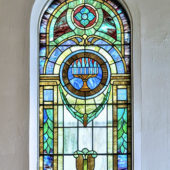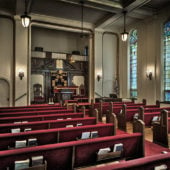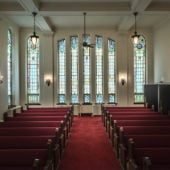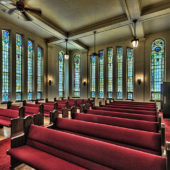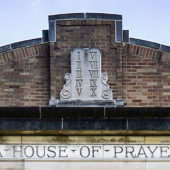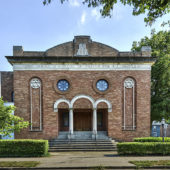An eclectic architectural style with a Byzanto-Romanesque exterior and Colonial Revival elements in the interior.
Temple Beth El is the only Jewish synagogue in Delaware Country, Indiana. Conflicting dates are given as to when the first Jews settled in Munseetown, as it was originally called. Some give the date as early as 1828 while other scholars say closer to the 1850s. Interestingly, Samuel Bamberger (1846-1926) the German born and only Jewish Governor of Utah, lived in Indianapolis and in Muncie, Indiana during the Civil War era. He was elected as Governor in 1916. The city officially adopted the name “Muncie” in 1854.
By 1852 there were enough Jews living in the area that a religious service was held at the home of Frank Leon, a clothing merchant, who was an important individual in Muncie civic affairs. In 1895 Beth El, a Reform congregation was officially formed. The congregation met in temporary quarters, such as the Masonic Lodge and homes, until 1922 when Temple Beth El was dedicated on West Jackson Street, where it is still located.
The original brick building is an eclectic mix of elements. The exterior, with its tall, round-arched windows, simple massing, and broad expanses of brick, could be characterized as “Byzanto-Romanesque”, a style widely utilized for Jewish houses of worship during the 1920’s. Here the details are modernized, however; the walls are relatively smooth and plain. The interior includes Colonial Revival elements, most notably the broken pediment above the Ark. A 1999 addition was designed in a modern style but in such a way that it blends in well with the original building.
Muncie’s Jewish population has never exceeded 200 people, therefore a full-time rabbi has never been possible. This has been a positive in the respect that Temple Beth El has been a place where student rabbis, mostly from Hebrew Union College of Cincinnati, can gain valuable pulpit experience.


